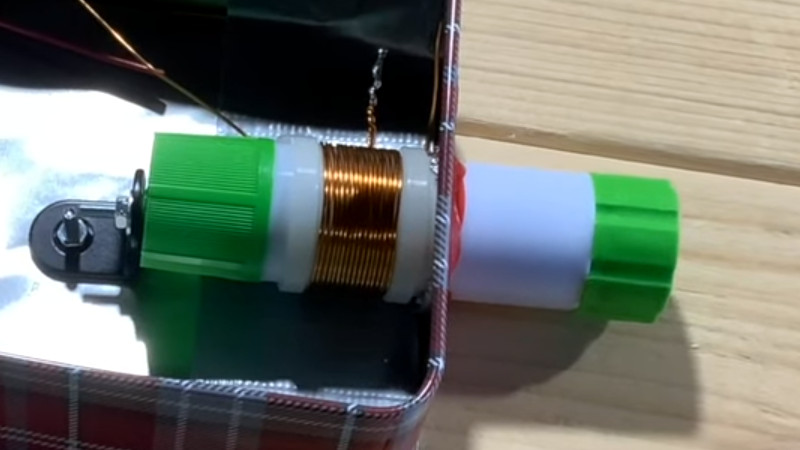A few months ago we brought you some experiments from [Bill Meara, N2CQR], in which he investigated the use of a glue stick as the former for a permeability tuned inductor. His set-up was very much in the spirit of experimentation, and we’re very pleased to now see [Nick, M0NTV] has taken the idea and demonstrated it for the 7 MHz, or 40 meter, amateur radio band.
The result can be seen in the video below the break, and is housed in a tin enclosure that we’re guessing once contained toffees. The oscillator circuit comes courtesy of [Ashar Farhan VU2ESE] of BitX transceiver fame, but we’re most interested in the glue stick coil former which makes use of a small bracket for stability. With the glue removed, he’s mounted a ferrite ring in its glue carrier which is moved in and out of the coil. We’re guessing this could also be done with other permeability-altering materials, for example we’d follow [VU2ESE]’s lead and try a piece of brass.
The knurled glue feed knob protrudes through a hole in the tin, and we’re guessing there’s enough separation for an operator’s hand not to drag the frequency too much. All in all given that variable capacitors are now something of a rarity, it makes for a useful demonstration of a very cheap replacement. Meanwhile, you can read our notes on [N2CQR]’s work here.
















With that pattern, the tin likely held shortbread.
This is really cool. Using an existing off-the-shelf solution which would normally be a waste item. I applaud.
I agree, this is what is called a hack.
Hack-a-meter = 11
Yeah. That was my first thought.
Finally an old school Hackaday style hack on Hackaday.
I wonder what that one shorted turn of tin-plated steel 4 mm away from the coil does for its Q?
Just a small technical note. Brass is not a permeability altering material. (Big note: I don’t say this because I’m some kind of radio genius, I say it because I spent the last several days pondering this exact thing, in part in Bill’s comment section. Bill was very patient with me :) He rocks.) Because brass isn’t permeable, it develops eddy currents that oppose the field generated by the inductor, effectively reducing the inductance. I discovered Bill is super patient when a few hours ago I listened to Soldersmoke episode #241 and discovered he’s explained the same thing there about 20 minutes in.☺️
I was just about to correct you then read the rest of your explanation and that makes perfect sense. Thank you
Aah yes, eddy currents. Like when you drop a magnet down a copper tube.
This is a coil rather than a tube, and brass isn’t really a magnet, but the interaction is still enough to cause a change in inductance.
Got that, thank you.
I laughed when I saw he ordered a box of glue sticks. (Experimentation justifies it however).
But, I was thinking this would be a good thing to try collecting for a Highschool physics class. Collect the glue sticks from the arts class (or perhaps the local elementary school), and use these in Direct Conversation receivers.
“Direct Conversation receivers” – is that when students in the physics class make direct conversation with the art students about receiving the glue sticks?
It took me the entire article before I realised this was about a glue *dispenser* (what we call a PrittStick in the UK).
For some reason I was picturing the stick of glue from a hot-glue gun and getting very confused.
A clever use of materials though, and I suppose you could do something similar with a lipstick/chapstick dispenser.
If only you people spoke proper English. 😉
<>
Every time the monarch changes, the language changes.
A real old school project a pleasant change from all that arduino stuff